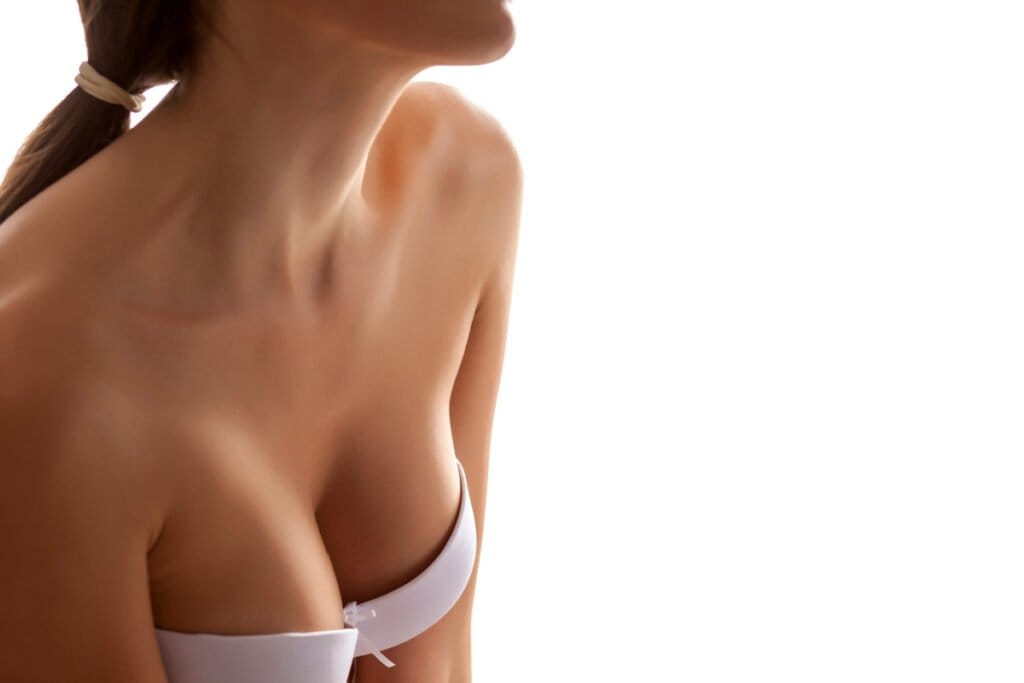

If you are hoping to have slightly larger breasts or address a deflated appearance after pregnancy, you may be looking into your breast augmentation options. While breast implants are the gold standard for improved breast shape and size, they are not the only way to increase breast volume: a small increase can be achieved without any implants, using your own fat. Ahead, learn more about how fat transfer breast augmentation works.
How does breast augmentation with fat transfer work?
Fat transfer breast augmentation is a surgical procedure that involves removing fat via liposuction from an area of the body such as the hips, flanks, stomach, or thighs and re-injecting that fat strategically into the breast to add volume. This technique can be customized to improve asymmetry, add cleavage, and/or increase volume up to about 1 cup size.
With fat transfer, the cosmetic surgeon’s technique is key. The fat that is harvested must be handled very carefully to preserve its ability to re-integrate in the breast area. Typically, only a percentage of the fat “takes” to the breast area. And because fat cannot add shape—only volume—your surgeon must take a careful approach to injection, ensuring that fat is injected evenly and at multiple depths in the areas where volume is desired. (You can read more about how to identify a skilled cosmetic surgeon here.)
For patients who do not have loose skin in the breasts, some surgeons utilize tissue expanders to help stretch the skin before surgery in order to achieve best results from fat grafting.
What are the side effects of fat grafting to the breasts?
After a fat transfer procedure, bruising, swelling, and soreness are common side effects in the donor site where you had liposuction performed. In your chest, you will likely experience swelling and bruising, but this area is not usually as tender. Fat grafting in breast surgery has a low rate of more serious complications, but there is a risk of fat necrosis in which the transferred fat dies; the formation of cysts or calcifications; and interference with breast cancer screenings.
A note about fat transfer & future mammograms
In some cases, the transferred fat may contribute to the formation of microcalcification, cysts, or nodules that are visible during mammograms, ultrasound, or MRI scans of the breasts. These issues could make it difficult for your provider to distinguish between benign areas and dangerous breast lumps, disrupting your routine breast cancer screening (and potentially leading to unnecessary biopsies). Studies have shown mixed results on this topic, however, and some experts believe that calcification of fat can be distinguished from cancerous nodules. More studies are needed to completely understand the effect of a fat transfer procedure on breast scans. As a result, some surgeons do not offer fat transfer to the breast.
Before undergoing fat grafting to the breasts, talk with your OB-GYN and board certified cosmetic surgeon about this potential issue, especially if you have a personal or family history of breast cancer. And after fat transfer surgery, it is key to inform your mammographer and medical providers about your procedure history.
Am I a good candidate for fat transfer breast augmentation?
While you may see this procedure called “minimally invasive,” liposuction and fat transfer are surgical procedures, typically performed under general anesthesia. To be a good candidate for this or any surgical procedure, you should be in excellent health and a non-smoker (or willing to abstain).
You are a good candidate for the aesthetic benefits that this procedure can provide if you identify with the following:
- You already are happy with your breast shape, but are looking for a small boost in volume; or, you want to add specific contour or symmetry to a small area.
- You are planning to keep your weight stable.
- You have some extra fat in the flanks, hips, or thighs.
Patients who have been pregnant may choose fat transfer if they desire a natural-looking improvement to breast volume, i.e. as part of a mommy makeover. After child-bearing, many women find their breasts have some loose skin and/or a deflated, ski slope-like upper pole. A moderate amount of this problem may make you a good candidate for fat transfer to the breasts.
Note that fat transfer can address a deflated appearance to your breasts, but it cannot raise a drooping breast or downward-facing nipples; a breast lift procedure is required in these cases. Fat transfer may be used in combination with a breast lift in certain cases where extra volume is desired, and it is often helpful for adding more upper pole fullness to lifted breasts.
What are the pros and cons of fat grafting in the breasts?
Pros of breast enhancement with fat:
- Compared with traditional breast augmentation, no implants are required, and therefore no need for routine breast implant checks (MRIs are recommended periodically for silicone-gel filled implants to check for rupture).
- Because it uses your own fat, this technique lends a very natural look and feel to the breasts.
- Patients enjoy the benefit of some body contouring thanks to the liposuction procedure used to harvest the fat.
- Fat transfer is a natural alternative to breast implants for women who want to avoid breast implants.
- Fat transfer is a useful tool for customizing breast reconstruction surgery, allowing your surgeon to more closely restore the look you desire.
- For patients who have had explant (breast implant removal) surgery and want to address a somewhat deflated appearance, fat transfer can be used to subtly restore volume.
- Fat transfer can be used to improve the appearance of breast implant rippling, a complication in which the breast implant texture shows through the skin (usually at the edges of an implant).
Cons of breast enhancement with fat:
- Fat transfer cannot achieve the more perky, structured, rounded breast appearance provided by breast implants—it can only add subtle volume to selected areas.
- Not all of the fat will take, or remain after a year; the amount of fat that will remain permanently is somewhat unpredictable, making it key to choose a skilled and experienced cosmetic surgeon.
- You may need multiple procedures, or a touch-up, either for cosmetic reasons or to avoid injecting too much fat at one time for the fat to take. For some patients, breast augmentation with implants may be preferable in order to avoid multiple procedures.
- A limited amount of fat can be injected—up to about 1 cup size worth of increase. Patients who desire a more noteworthy change are usually best served with breast implants.
- Maintaining your results requires maintaining a stable weight; since fat in your breasts behaves the same as fat throughout your body, they will shrink if you lose weight.
- There is a risk of transferred fat forming calcifications or cysts that may interfere with routine breast surveillance.
Choose an experienced, fellowship-trained cosmetic surgeon
Successful fat transfer breast augmentation is contingent on one very important choice: your surgeon. Cosmetic surgeons who are certified by the American Board of Cosmetic Surgery (ABCS) are highly skilled cosmetic specialists who can help you determine which breast augmentation method is right for you and achieve beautiful surgical results safely. To find a board certified cosmetic surgeon near you, browse our surgeon directory.


